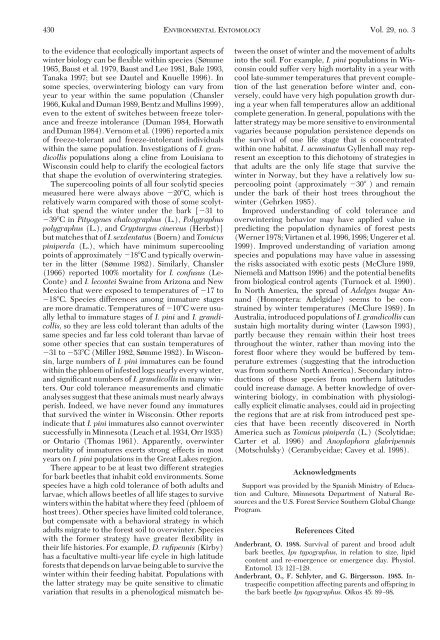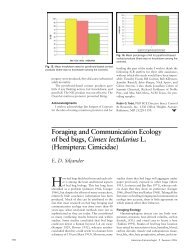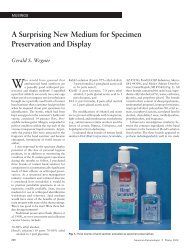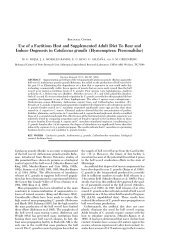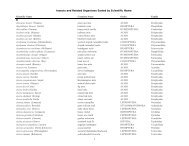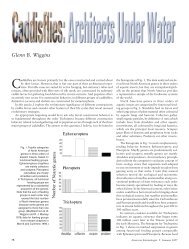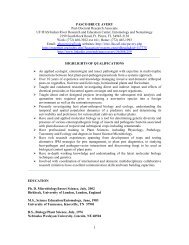Cold Tolerance of Four Species of Bark Beetle (Coleoptera ...
Cold Tolerance of Four Species of Bark Beetle (Coleoptera ...
Cold Tolerance of Four Species of Bark Beetle (Coleoptera ...
You also want an ePaper? Increase the reach of your titles
YUMPU automatically turns print PDFs into web optimized ePapers that Google loves.
430 ENVIRONMENTAL ENTOMOLOGY Vol. 29, no. 3<br />
to the evidence that ecologically important aspects <strong>of</strong><br />
winter biology can be ßexible within species (Sømme<br />
1965, Baust et al. 1979, Baust and Lee 1981, Bale 1993,<br />
Tanaka 1997; but see Dautel and Knuelle 1996). In<br />
some species, overwintering biology can vary from<br />
year to year within the same population (Chansler<br />
1966, Kukal and Duman 1989, Bentz and Mullins 1999),<br />
even to the extent <strong>of</strong> switches between freeze tolerance<br />
and freeze intolerance (Duman 1984, Horwath<br />
and Duman 1984). Vernom et al. (1996) reported a mix<br />
<strong>of</strong> freeze-tolerant and freeze-intolerant individuals<br />
within the same population. Investigations <strong>of</strong> I. grandicollis<br />
populations along a cline from Louisiana to<br />
Wisconsin could help to clarify the ecological factors<br />
that shape the evolution <strong>of</strong> overwintering strategies.<br />
The supercooling points <strong>of</strong> all four scolytid species<br />
measured here were always above 20C, which is<br />
relatively warm compared with those <strong>of</strong> some scolytids<br />
that spend the winter under the bark [31 to<br />
39C inPityogenes chalcographus (L.), Polygraphus<br />
polygraphus (L.), and Crypturgus cinereus (Herbst)]<br />
but matches that <strong>of</strong> I. sexdentatus (Boern) and Tomicus<br />
piniperda (L.), which have minimum supercooling<br />
points <strong>of</strong> approximately 18C and typically overwinter<br />
in the litter (Sømme 1982). Similarly, Chansler<br />
(1966) reported 100% mortality for I. confusus (Le-<br />
Conte) and I. lecontei Swaine from Arizona and New<br />
Mexico that were exposed to temperatures <strong>of</strong> 17 to<br />
18C. <strong>Species</strong> differences among immature stages<br />
are more dramatic. Temperatures <strong>of</strong> 10C were usually<br />
lethal to immature stages <strong>of</strong> I. pini and I. grandicollis,<br />
so they are less cold tolerant than adults <strong>of</strong> the<br />
same species and far less cold tolerant than larvae <strong>of</strong><br />
some other species that can sustain temperatures <strong>of</strong><br />
31 to 53C (Miller 1982, Sømme 1982). In Wisconsin,<br />
large numbers <strong>of</strong> I. pini immatures can be found<br />
within the phloem <strong>of</strong> infested logs nearly every winter,<br />
and signiÞcant numbers <strong>of</strong> I. grandicollis in many winters.<br />
Our cold tolerance measurements and climatic<br />
analyses suggest that these animals must nearly always<br />
perish. Indeed, we have never found any immatures<br />
that survived the winter in Wisconsin. Other reports<br />
indicate that I. pini immatures also cannot overwinter<br />
successfully in Minnesota (Leach et al. 1934, Orr 1935)<br />
or Ontario (Thomas 1961). Apparently, overwinter<br />
mortality <strong>of</strong> immatures exerts strong effects in most<br />
years on I. pini populations in the Great Lakes region.<br />
There appear to be at least two different strategies<br />
for bark beetles that inhabit cold environments. Some<br />
species have a high cold tolerance <strong>of</strong> both adults and<br />
larvae, which allows beetles <strong>of</strong> all life stages to survive<br />
winters within the habitat where they feed (phloem <strong>of</strong><br />
host trees). Other species have limited cold tolerance,<br />
but compensate with a behavioral strategy in which<br />
adults migrate to the forest soil to overwinter. <strong>Species</strong><br />
with the former strategy have greater ßexibility in<br />
their life histories. For example, D. rufipennis (Kirby)<br />
has a facultative multi-year life cycle in high latitude<br />
forests that depends on larvae being able to survive the<br />
winter within their feeding habitat. Populations with<br />
the latter strategy may be quite sensitive to climatic<br />
variation that results in a phenological mismatch be-<br />
tween the onset <strong>of</strong> winter and the movement <strong>of</strong> adults<br />
into the soil. For example, I. pini populations in Wisconsin<br />
could suffer very high mortality in a year with<br />
cool late-summer temperatures that prevent completion<br />
<strong>of</strong> the last generation before winter and, conversely,<br />
could have very high population growth during<br />
a year when fall temperatures allow an additional<br />
complete generation. In general, populations with the<br />
latter strategy may be more sensitive to environmental<br />
vagaries because population persistence depends on<br />
the survival <strong>of</strong> one life stage that is concentrated<br />
within one habitat. I. acuminatus Gyllenhall may represent<br />
an exception to this dichotomy <strong>of</strong> strategies in<br />
that adults are the only life stage that survive the<br />
winter in Norway, but they have a relatively low supercooling<br />
point (approximately 30 ) and remain<br />
under the bark <strong>of</strong> their host trees throughout the<br />
winter (Gehrken 1985).<br />
Improved understanding <strong>of</strong> cold tolerance and<br />
overwintering behavior may have applied value in<br />
predicting the population dynamics <strong>of</strong> forest pests<br />
(Werner 1978; Virtanen et al. 1996, 1998; Ungerer et al.<br />
1999). Improved understanding <strong>of</strong> variation among<br />
species and populations may have value in assessing<br />
the risks associated with exotic pests (McClure 1989,<br />
Niemelä and Mattson 1996) and the potential beneÞts<br />
from biological control agents (Turnock et al. 1990).<br />
In North America, the spread <strong>of</strong> Adelges tsugae Annand<br />
(Homoptera: Adelgidae) seems to be constrained<br />
by winter temperatures (McClure 1989). In<br />
Australia, introduced populations <strong>of</strong> I. grandicollis can<br />
sustain high mortality during winter (Lawson 1993),<br />
partly because they remain within their host trees<br />
throughout the winter, rather than moving into the<br />
forest ßoor where they would be buffered by temperature<br />
extremes (suggesting that the introduction<br />
was from southern North America). Secondary introductions<br />
<strong>of</strong> those species from northern latitudes<br />
could increase damage. A better knowledge <strong>of</strong> overwintering<br />
biology, in combination with physiologically<br />
explicit climatic analyses, could aid in projecting<br />
the regions that are at risk from introduced pest species<br />
that have been recently discovered in North<br />
America such as Tomicus piniperda (L.) (Scolytidae;<br />
Carter et al. 1996) and Anoplophora glabripennis<br />
(Motschulsky) (Cerambycidae; Cavey et al. 1998).<br />
Acknowledgments<br />
Support was provided by the Spanish Ministry <strong>of</strong> Education<br />
and Culture, Minnesota Department <strong>of</strong> Natural Resources<br />
and the U.S. Forest Service Southern Global Change<br />
Program.<br />
References Cited<br />
Anderbrant, O. 1988. Survival <strong>of</strong> parent and brood adult<br />
bark beetles, Ips typographus, in relation to size, lipid<br />
content and re-emergence or emergence day. Physiol.<br />
Entomol. 13: 121Ð129.<br />
Anderbrant, O., F. Schlyter, and G. Birgersson. 1985. IntraspeciÞc<br />
competition affecting parents and <strong>of</strong>fspring in<br />
the bark beetle Ips typographus. Oikos 45: 89Ð98.


